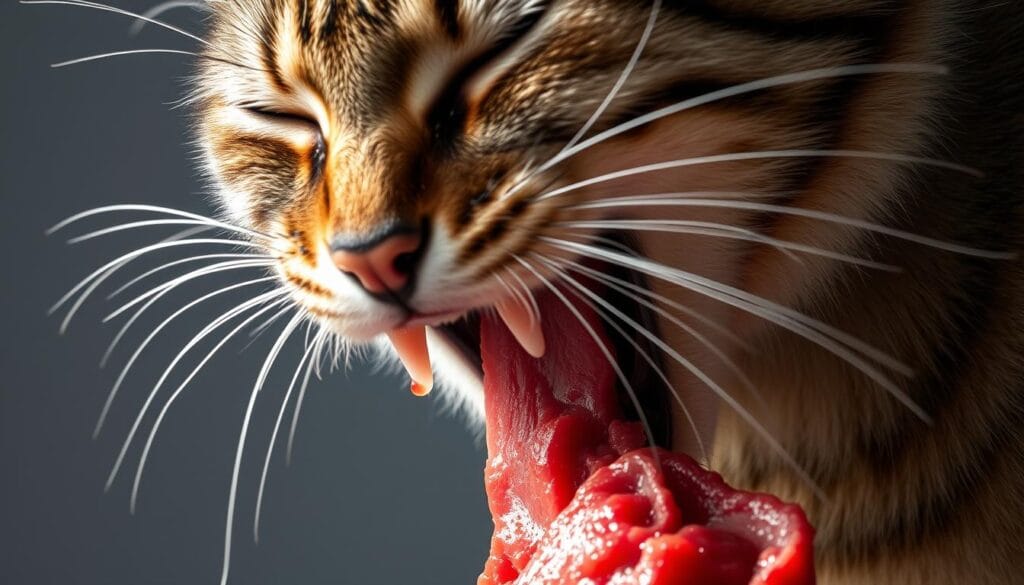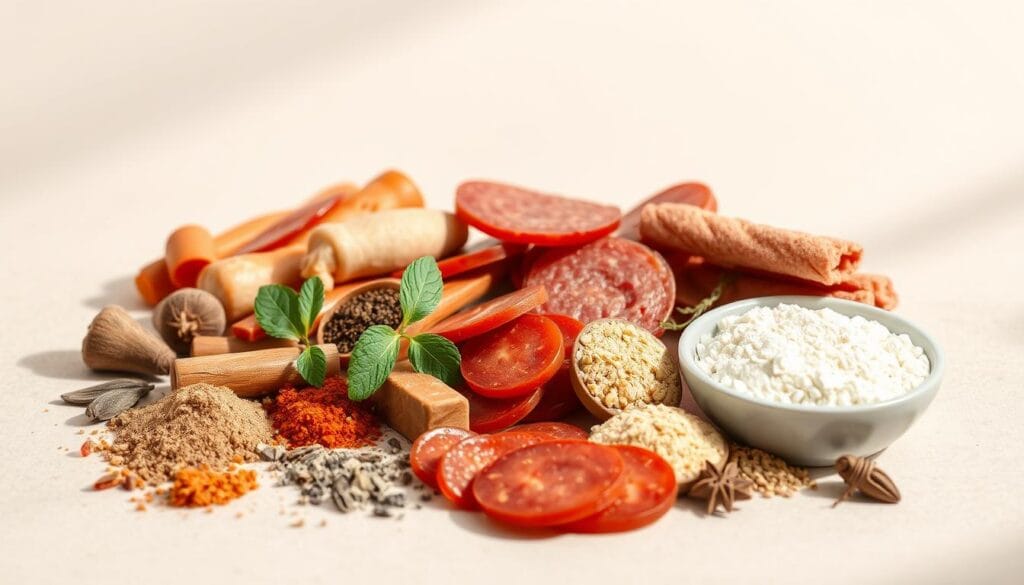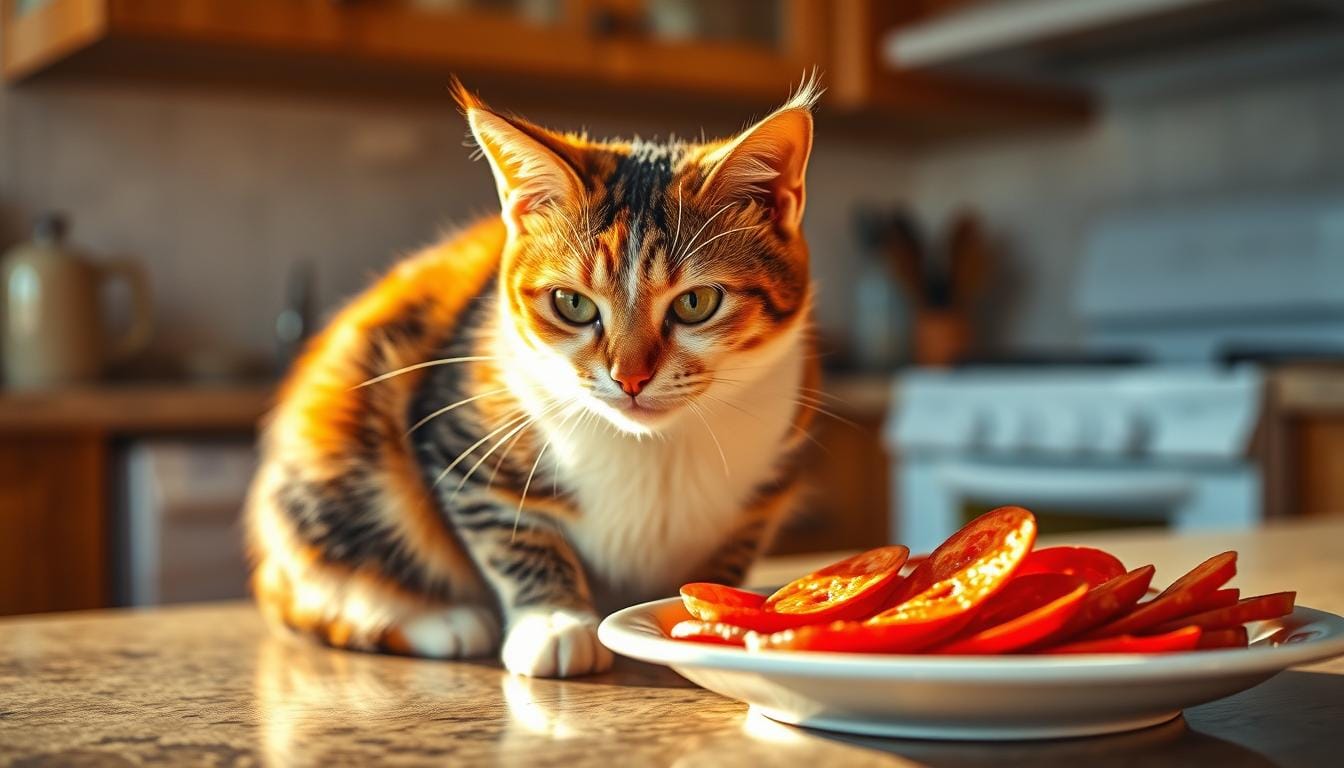Can Cats Eat Pepperoni? Nutrition Facts & Health Risks
You’re enjoying a slice of pizza when those big, curious eyes lock onto your plate. Your feline companion’s whiskers twitch as they zero in on the salty, spicy topping. It’s tempting to share a bite, but those pleading looks hide hidden dangers.
Pepperoni’s origins trace back to Italy, where “peperone” refers to bell peppers. But this modern cured meat packs a punch far beyond its name. A single 2-gram slice contains over 31 mg of sodium – triple what a 9-pound pet needs daily. Even a tiny piece delivers a risky surge of fat and salt.
Table of Contents
Why do our furry friends crave it? Their instincts drive them toward meaty flavors, but processed foods clash with their biology. Your companion’s digestive system isn’t built for garlic, paprika, or preservatives lurking in this snack. Sharing could lead to vomiting, dehydration, or long-term organ strain.
This guide will help you navigate those “should I or shouldn’t I?” moments at the dinner table. You’ll learn how pepperoni’s ingredients disrupt feline health and discover safer, tail-friendly alternatives that keep purrs rolling in. Because true love means protecting them – even from their own cravings.
Understanding Your Cat’s Dietary Needs
Your furry companion’s intense focus on meat-based snacks stems from 9,500 years of evolution. Unlike humans or dogs, their bodies demand animal-derived nutrients to function properly – a legacy from wild ancestors who thrived on fresh prey.

Essential Building Blocks for Health
Obligate carnivores require specific nutrients found only in meat. Taurine – an amino acid critical for heart health – can’t be synthesized internally. Without adequate protein from animal sources, your pet risks developing vision problems and weakened immunity.
| Nutrient | Animal Sources | Plant Sources |
|---|---|---|
| Taurine | Chicken, Fish | None |
| Arachidonic Acid | Liver, Eggs | Trace amounts |
| Vitamin A | Active form in meat | Inactive precursors |
Built for Meat Consumption
Sharp molars for tearing flesh and a short digestive tract designed for rapid meat processing reveal their biological design. Their extraordinary sense of smell detects meat aromas at concentrations 14 times lower than humans can perceive – explaining why cured meats grab their attention.
Modern pets share 95% of their DNA with African wildcats. This genetic blueprint dictates their need for moisture-rich, high-protein meals rather than dry, carbohydrate-heavy foods. Meeting these needs helps maintain lean muscle mass and supports kidney function.
What is Pepperoni and What’s in It?
Pepperoni’s vibrant red color and bold aroma make it a pizza favorite, but its composition tells a different story. This cured meat combines pork, beef, and a cocktail of additives that create health hazards for pets. Let’s dissect what makes this popular topping problematic.

Key Ingredients and Their Impact
The salami-style meat relies on sodium nitrates for preservation and color retention. These chemicals prevent bacterial growth but convert to harmful compounds in acidic environments like your pet’s stomach. Garlic powder – present in most recipes – contains thiosulfate, which destroys red blood cells even in trace amounts.
Spices like paprika and chili flakes add heat that overwhelms sensitive taste buds. Black pepper triggers stomach lining irritation, while excess salt disrupts electrolyte balance. Each slice packs enough sodium to surpass a day’s safe limit for small animals.
Nutritional Breakdown and Hidden Risks
One ounce of this processed meat delivers alarming nutrient levels mismatched with feline needs. Compare these values to daily requirements:
| Nutrient | Pepperoni Content | Feline Daily Limit | Excess Risk |
|---|---|---|---|
| Sodium | 476 mg | 42 mg | Dehydration, kidney strain |
| Nitrates | 0.5-1.2 mg | 0 mg | Blood cell damage |
| Garlic | 0.3% by weight | 0% | Anemia |
| Spices | 2-4% | 0% | Digestive inflammation |
Fat content reaches 16 grams per 100-gram serving – nearly triple what most pets need. Combined with preservatives, these elements form a toxic trifecta that stresses vital organs over time.
Can Cats Eat Pepperoni?
That irresistible meaty aroma might make your furry friend beg, but their biology tells a different story. Processed meats like this pizza topping contain ingredients that clash with feline digestive systems – even in tiny quantities.
Evaluating the Risks Involved
A single thin slice contains enough sodium to cover three days’ needs for a 10-pound pet. Preservatives like nitrates convert to harmful compounds during digestion, while spices irritate sensitive stomachs. Regular nibbles could lead to:
- Dehydration from salt overload
- Pancreatic inflammation from high fat
- Anemia risk from garlic compounds
Portion Control and Special Occasions
If you must offer this snack, keep portions smaller than a pinky nail – once monthly at most. Veterinarians sometimes suggest microscopic amounts for:
- Medication concealment emergencies
- Training breakthrough rewards
- Appetite stimulation in ill pets
Always remove the greasy outer layer and rinse pieces to reduce salt content. Safer alternatives like freeze-dried chicken or fish flakes provide meaty satisfaction without hidden dangers. Remember – those pleading eyes don’t understand long-term consequences, but you do.
Health Risks Associated with Pepperoni for Cats
That tempting slice on your plate hides a cocktail of dangers for curious pets. While the savory aroma might seem harmless, even small amounts of processed meats can trigger severe reactions in feline companions.
Sodium, Nitrates, and Spices Concerns
Excessive salt content poses immediate threats. A single ounce contains 11 times more sodium than your pet’s daily limit. This overload strains kidneys and may lead to tremors or seizures within hours.
Garlic powder – common in cured meats – damages red blood cells. Pale gums and sudden lethargy signal anemia, requiring urgent vet care. Spices like paprika irritate delicate digestive systems, often causing repeated vomiting.
| Ingredient | Effect | Emergency Signs |
|---|---|---|
| Sodium | Kidney failure | Excessive thirst, confusion |
| Nitrates | Blood cell damage | Weakness, rapid breathing |
| Garlic | Anemia | Pale tongue, collapse |
| High Fat | Pancreatitis | Hunched back, refusal to eat |
Pancreatitis risks skyrocket with fatty foods. This painful condition demands hospitalization and IV fluids. Preservatives like sodium nitrate accumulate in organs, creating long-term toxic effects.
Watch for subtle changes first – a tender stomach or unusual tiredness. These early warnings help prevent full-blown crises. Your vigilance keeps those purrs coming safely.
Pepperoni vs. Other Meats: Making the Right Choice
Choosing between processed and fresh proteins requires understanding what fuels your pet’s health. While cured snacks might smell tempting, their nutritional profiles tell wildly different stories for carnivorous companions.
Processed Meats Compared to Natural Options
Deli selections like salami share pepperoni’s risky traits – excessive sodium, preservatives, and irritating spices. These additives strain organs and offer minimal nutritional value. Fresh options like boiled chicken or turkey breast provide pure protein without hidden threats.
| Meat Type | Key Concerns | Benefits |
|---|---|---|
| Pepperoni/Salami | High salt, nitrates, garlic | None |
| Chicken/Turkey | None when plain | Muscle support, easy digestion |
| Fish (Salmon/Cod) | Mercury risk in large amounts | Omega-3s for skin/coat |
Simple preparation makes all the difference. Unseasoned cooked meats retain natural nutrients while avoiding digestive upset. For shellfish lovers, shrimp offers lean protein – just remove shells and cook thoroughly.
While dogs might tolerate occasional deli slices, feline biology demands cleaner fuel. Your smartest choice? Stick to single-ingredient proteins that mirror what hunters would catch in the wild. Those satisfied purrs will confirm you’ve made the right call.
Tips for Offering Treats Safely to Your Cat
Your feline companion’s curiosity at snack time demands smart strategies. Thoughtful treat practices balance enjoyment with wellness, requiring you to become a keen observer of subtle body language and habits.
Spotting Trouble Before It Escalates
Learn your pet’s normal rhythms – how often they visit the water bowl, their preferred nap spots, and typical litter box patterns. Sudden deviations like refusing favorite foods or avoiding eye contact often signal discomfort.
Watch for these red flags after introducing new snacks:
- Excessive lip-smacking or drooling
- Uncharacteristic hiding under furniture
- Repeated trips to the litter box with no results
Mild symptoms might resolve within 12 hours with rest and hydration. Persistent vomiting – especially with bile – warrants immediate vet consultation. Dehydration risks spike rapidly in smaller animals.
| Normal Behavior | Warning Sign |
|---|---|
| Playful after meals | Lethargic posture |
| Consistent appetite | Ignoring food bowls |
| Soft purring | Growling when touched |
Keep a journal noting treat types, portions, and reactions. This record helps your veterinarian pinpoint triggers during checkups. When in doubt, skip questionable snacks and opt for vet-approved options.
Safer Alternatives and Smart Feeding Practices
Smart treat choices can keep your feline friend healthy without sacrificing their enjoyment. While processed snacks pose risks, simple swaps deliver both flavor and nutrition tailored to carnivorous needs.
Healthier Meat Options
Fresh proteins prepared simply outshine processed meats. These options align with biological needs while minimizing health risks:
| Meat | Key Benefits | Preparation Tips |
|---|---|---|
| Chicken Breast | High-quality protein source | Boil plain, shred into bits |
| Turkey | Low-fat muscle support | Remove skin, bake without seasoning |
| Salmon | Omega-3 fatty acids | Cook thoroughly, debone carefully |
| Shrimp | Natural appetite stimulant | Steam, remove shells completely |
Rotate these proteins to maintain interest. Always avoid garlic, onions, and heavy oils – even small amounts cause issues. Combine with high-quality cat food for balanced meals.
Consulting Your Veterinarian
Your vet tailors advice to your pet’s unique needs. They consider weight, existing conditions, and activity levels when suggesting:
Protein ratios for senior pets
Hydration strategies for dry food diets
Treat frequency to prevent obesity
Schedule annual nutritional checkups. Bring your pet’s favorite food labels to discuss ingredients. This collaboration ensures your companion thrives on meals as unique as their personality.
Wrapping Up Your Cat’s Diet Decisions
While sharing a slice might feel like bonding, your feline friend’s health depends on your choices. Over half of all pizzas contain pepperoni – a tempting but dangerous topping for pets. Garlic, onions, and lactose-heavy cheese turn this human favorite into a toxic trio for sensitive digestive systems.
Common kitchen dangers like chocolate, grapes, and raw meats highlight why your plate isn’t their menu. Even tiny amounts of processed foods add up, increasing risks for organ strain or anemia over time.
Veterinarians recommend sticking to species-appropriate proteins. Fresh chicken, turkey, or commercial treats designed for felines satisfy cravings safely. Those whisker-twitching moments call for wisdom – not indulgence.
Your role? Protect their nine lives by choosing snacks that nourish rather than harm. True care means saying “no” to shared pizza nights and yes to long-term vitality.
Read also :
- Dry Cat Food Recipes
- Wet cat Food Recipes
- Special Cat Food Recipes
- Chicken Cat Food Recipes
- Homemade Cat Food Recipes
- Can cats eat chicken and what are the health benefits?
- Can cats have chicken as a protein source? Comprehensive guide
- Can Cats Eat Raw Chicken? Safety Guide for Cat Owners
- Dry Cat Food Brands Loved by Cats and Trusted by Vets
- Best Cat Food for Sensitive Stomach:Top 5 Vet-Approved Picks
- Special Kitty Kitten Food – Learn the Pros and Cons
- prescription cat food-Top 10 Prescription Cat Foods
- Wet Cat Food for Kittens: Top Nutritious Choices 2025
- How Long Can Wet Cat Food Sit Out? Critical Facts
- American Veterinary Medical Association (AVMA)

